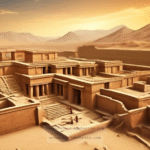What Happened During the 1976 Tehran UFO Incident and Why Does It Remain Unexplained?
What Happened During the 1976 Tehran UFO Incident and Why Does It Remain Unexplained?
The 1976 Tehran UFO incident is one of the most compelling and enigmatic encounters in the annals of UFO history. On September 19, 1976, multiple witnesses, including military personnel and civilians, reported seeing a bright object in the night sky over Tehran, Iran. The incident involved two F-4 Phantom fighter jets dispatched to investigate the phenomenon, only to experience mysterious malfunctions. This incident not only raises profound questions about the nature of UFOs but also highlights the intersection of military, politics, and the unknown. So, what truly transpired during that fateful night, and why does it remain shrouded in mystery? Let’s delve into the details of this captivating case.
Historical Context: Iran in 1976
Understanding the Tehran UFO incident requires a look at the historical and political landscape of Iran in 1976. At the time, Iran was under the rule of Shah Mohammad Reza Pahlavi, whose regime was known for its close ties with the United States. The geopolitical climate was tense, with rising discontent among the populace leading to the Iranian Revolution just a few years later in 1979. This context is crucial as it underscores the military’s readiness to respond to any perceived threats, including unidentified aerial phenomena.
In the backdrop of Cold War tensions, Iranian military forces were on high alert for potential incursions from neighboring countries. Thus, when reports of an unidentified object began to surface, it triggered an immediate response from the Iranian Air Force. The incident unfolded in a charged atmosphere, where the implications of a UFO sighting could have severe political ramifications.
The Incident: A Night of Unexplained Phenomena
On the evening of September 19, 1976, residents of Tehran reported seeing a bright, pulsating light in the sky. The Iranian Air Force scrambled two F-4 Phantom jets to investigate the source of the disturbance. What transpired next is both remarkable and perplexing. As the pilots approached the object, they found their instruments malfunctioning, including radar systems and communication devices. Despite being highly trained and equipped, the pilots reported feeling a sense of disorientation and unease.
One of the pilots, Colonel Parviz Jafari, later described his experience: “As we approached, the object began to move rapidly. We tried to lock on with our missiles, but our systems failed.” This statement highlights the eerie technological interference that has become a hallmark of many UFO sightings.
Core Concepts: What Makes the Tehran Incident Unique?
The Tehran UFO incident is unique due to several factors. Firstly, it involved multiple credible witnesses, including military personnel, which adds a layer of legitimacy to the claims. Secondly, the malfunction of military aircraft systems during the encounter raises significant questions about the technology and capabilities of the unidentified object. Lastly, the incident occurred during a politically sensitive time, amplifying the stakes involved in the investigation.
Moreover, the Iranian government, at the time, was not known for embracing the concept of UFOs, making the military’s response all the more intriguing. The official acknowledgment of the incident by the Iranian Air Force and the subsequent investigations lend credence to the seriousness with which the military treated the sighting.
Practical Implications: Military and Civilian Responses
The Tehran UFO incident had immediate implications for both military and civilian sectors. The Iranian Air Force conducted an investigation into the sighting, leading to heightened alertness regarding aerial phenomena. This incident also sparked interest among UFO researchers worldwide, leading to increased scrutiny of military engagements with unidentified objects. Civilian responses varied widely, with some expressing skepticism while others embraced the incident as evidence of extraterrestrial visitation.
In the years following the incident, various military organizations, including the U.S. Air Force, have reviewed the case. Despite numerous attempts to explain the sighting through conventional means—such as weather balloons, aircraft, or natural phenomena—none have been fully satisfactory. The ongoing interest in the incident illustrates its lasting impact on both military protocol and public fascination with the unknown.
Alternative Perspectives: Skeptics vs. Believers
As with many UFO incidents, the Tehran event has drawn both skeptics and believers into heated debates. Skeptics argue that the pilots may have misidentified the object, attributing their experiences to psychological factors or natural phenomena. Some propose that the bright light could have been a conventional aircraft, a satellite, or even atmospheric phenomena like meteorological balloons.
On the other hand, believers argue that the combination of credible witnesses, military involvement, and the technological anomalies experienced during the encounter points toward an extraterrestrial origin. They highlight the fact that such phenomena often occur near military installations, suggesting a possible interest by otherworldly beings in human military activities.
Common Misconceptions: Debunking Myths
There are several misconceptions surrounding the Tehran UFO incident that deserve clarification. One common myth is that the military completely dismissed the event. In reality, the Iranian Air Force took the sighting seriously, conducting an investigation and even presenting findings to military officials.
Another misconception is that all UFO sightings can be easily explained. While many sightings can indeed be attributed to mundane phenomena, the Tehran incident stands out due to the credible witnesses and the nature of the encounter. It is essential to differentiate between hoaxes or misidentifications and cases that remain unexplained despite thorough investigation.
Best Practices for Investigation and Study
Investigating UFO sightings requires a systematic approach. Here are some best practices for researchers and enthusiasts:
- Collect Witness Testimonies: Gather detailed accounts from credible witnesses, prioritizing those with military or aviation backgrounds.
- Corroborate Evidence: Seek physical evidence such as radar data, photographs, or videos that can support witness claims.
- Consult Experts: Engage with aerospace engineers, physicists, and psychologists to analyze the data from various angles.
- Remain Open-Minded: Keep an open mind to both conventional explanations and extraordinary possibilities.
- Document Findings: Maintain thorough records of investigations to contribute to the broader body of UFO research.
Future Developments: Ongoing Research and Interest
As technology advances, so does our capacity to investigate UFO phenomena. The advent of sophisticated imaging tools, artificial intelligence, and improved radar systems may allow for more precise monitoring of aerial phenomena. Ongoing research into historical cases, including the Tehran incident, continues to attract academic and scientific interest.
Organizations such as the Mutual UFO Network (MUFON) and the Center for the Study of Extraterrestrial Intelligence (CSETI) actively encourage research into unexplained sightings. With the recent declassification of military UFO reports, interest in this field is at an all-time high, leading to a resurgence in public and governmental interest in uncovering the mysteries of unidentified aerial phenomena.
Conclusion: The Unsolved Mystery of the Tehran UFO Incident
The Tehran UFO incident remains one of the most intriguing and unexplained cases in UFO history. The combination of credible witnesses, military involvement, and technological anomalies creates a compelling narrative that continues to capture the imagination of the public. As researchers and enthusiasts delve deeper into this mystery, the question of whether we are alone in the universe remains a tantalizing enigma. The Tehran incident serves as a reminder of the vast unknowns that still exist, urging us to explore, investigate, and remain curious about the world beyond our own.
Other Articles
Recent Posts
- What Happened to Flight MH370? The Conspiracy Theories That Still Haunt Us
- What Secrets Lurk Within the Walls of the Infamous Trans-Allegheny Lunatic Asylum?
- What Evidence Supports the Existence of Bigfoot in the Pacific Northwest?
- What Happened to the Indus Valley Civilization? Unraveling the Mysteries of Ancient Urban Life
- Can Telepathy Be Scientifically Proven Through Laboratory Evidence?







